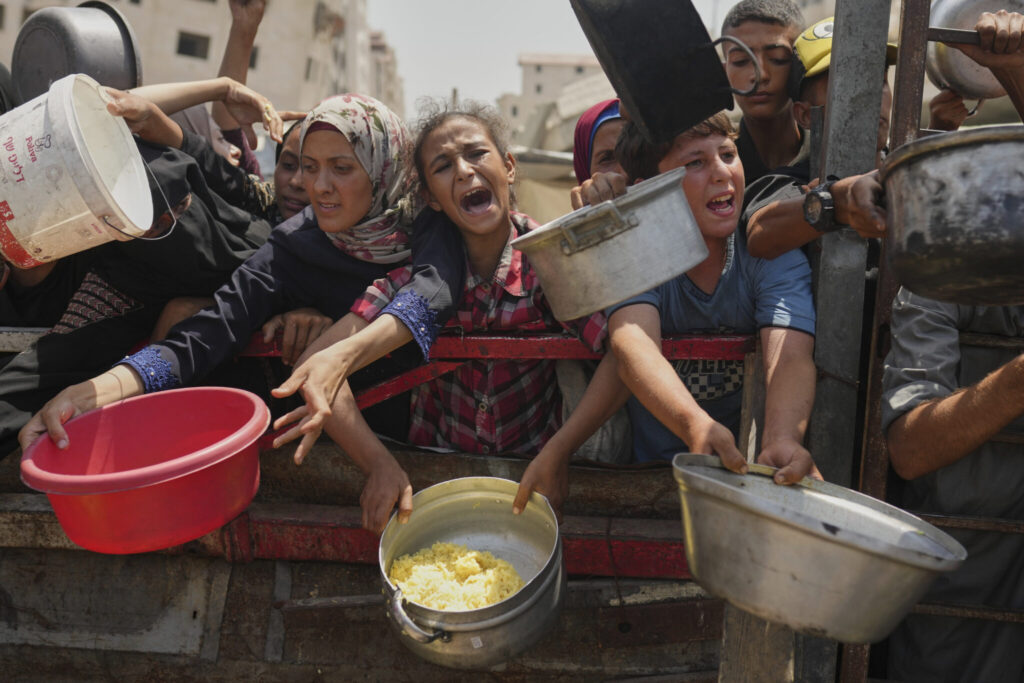Famine Confirmed in Gaza City, IPC Warns Spread/ Newslooks/ WASHINGTON/ J. Mansour/ Morning Edition/ Gaza City has officially entered a state of famine, the first such declaration in the Middle East by the IPC. Without a ceasefire and increased humanitarian access, the crisis could rapidly spread to other regions. Israel disputes the findings, but aid groups warn of catastrophic hunger and rising deaths.

Gaza Famine Crisis: Quick Looks
- Famine declared in Gaza City by the Integrated Food Security Phase Classification (IPC).
- Over 500,000 people face catastrophic hunger across Gaza.
- Famine likely to spread to Deir al-Balah and Khan Younis by late September.
- Israel disputes famine claim, calling IPC findings “false and biased.”
- Malnutrition and starvation-related deaths rising, especially among children.
- Aid restrictions and active conflict driving collapse of food systems.
- Families report severe hunger, malnourishment, and inability to buy food.
- IPC says conditions meet famine threshold despite data collection challenges.
- Humanitarian groups call for immediate ceasefire and aid access.

Famine Confirmed in Gaza City, IPC Warns Spread
Deep Look
GAZA CITY, Gaza Strip — A dire humanitarian emergency has escalated into an official famine in Gaza City, according to a formal declaration by the Integrated Food Security Phase Classification (IPC), the global authority on food insecurity. In a report released Friday, the IPC warned that the crisis is not only present but likely to intensify and spread throughout the Gaza Strip in the absence of a ceasefire and immediate, unrestricted humanitarian aid.
This marks the first official famine declaration in the Middle East by the IPC and comes after months of escalating alarms from aid organizations working in the region. The situation follows nearly two years of conflict, which began after the October 2023 Hamas attack on Israel and the ensuing full-scale Israeli military campaign.
Over Half a Million in Catastrophic Conditions
According to the IPC, more than 500,000 Palestinians — roughly a quarter of Gaza’s population — are facing catastrophic food insecurity. The report says Gaza City, the strip’s largest urban area, already meets all famine criteria and predicts the crisis will likely spread southward to Deir al-Balah and Khan Younis by the end of September.
The situation has worsened due to a combination of factors:
- Restricted access to humanitarian aid
- Ongoing airstrikes and ground offensives
- Widespread displacement
- Collapse of Gaza’s local food systems
The IPC report warned that the death toll from malnutrition, especially among children, will continue to rise without a massive, immediate humanitarian response.
Israel Rejects Famine Designation
Despite graphic images and firsthand accounts from Gaza, the Israeli government denies famine is occurring. Prime Minister Benjamin Netanyahu labeled the reports “Hamas propaganda,” and the military agency COGAT claimed the IPC’s findings were “false and biased.”
Israel has stated that over 100,000 trucks of aid have entered Gaza since the war began, especially in recent weeks. However, U.N. agencies and local residents argue that the scale of the aid falls far short of the massive need. Many Palestinians must travel through dangerous territory to receive aid due to Israeli military controls.
How the IPC Declares Famine
A formal famine declaration requires three criteria:
- At least 20% of households face extreme food shortages.
- At least 30% of children under five are acutely malnourished.
- At least two people (or four children) per 10,000 are dying daily from starvation or disease linked to malnutrition.
While full mortality data from Gaza is difficult to obtain due to the conflict, the IPC report concluded that all indicators strongly suggest the thresholds have been met between July 1 and August 15.
Field Reports Reveal Devastating Hunger
In hospitals across Gaza City, medical workers describe the physical toll of famine in harrowing detail. Australian emergency nurse Kirsty Blacka, who worked at Al-Quds Hospital, said young, healthy men arrived looking “like teenagers” from extreme weight loss. Infections from contaminated water worsen the situation, particularly for children and the elderly.
“People are dying not just from hunger, but because they’re too weak to survive diseases,” said Blacka.
For families like Yousef Sbeteh’s, the crisis is personal. His 15-year-old daughter Aya, injured in a June airstrike, has lost 20 kilograms (44 pounds) while hospitalized. Her brother Ahmad, 17, has lost 15 kilograms (33 pounds). Doctors say the teens had no pre-existing conditions but are wasting away due to lack of protein and medical nutrition.
“She needs meat, fish, supplements,” Sbeteh said. “But I can’t buy anything anymore.”
Expert Opinions and Global Warnings
Famine expert Alex de Waal, author of Mass Starvation: The History and Future of Famine, said Israel’s limited access for aid groups delayed the famine declaration.
“If full data collection had been allowed, the world would have known months ago,” he said. “It’s tragic how long it takes for these warnings to be heeded.”
He criticized the global community for inaction, saying that famine designations often come too late for the most vulnerable.
Ceasefire, Aid Access Urgently Needed
The IPC and humanitarian groups stress that the only way to prevent mass deaths is an immediate ceasefire and unrestricted access to Gaza for aid workers and supplies.
But Israeli leadership continues to press ahead with planned escalations in Gaza City, even as the area is recognized as a famine zone. Critics say this proves that starvation is being used as a strategic weapon.
“This is not just negligence — it’s intentional,” said Chris Newton of the International Crisis Group. “Starvation is part of Israel’s war strategy.”







